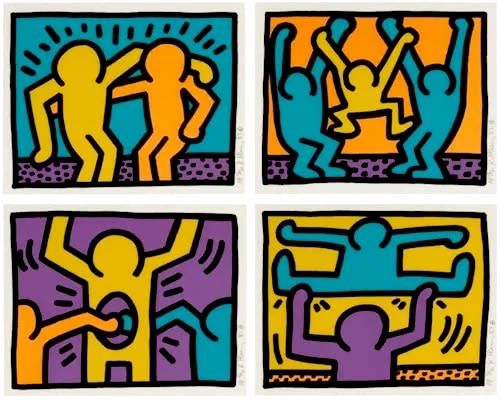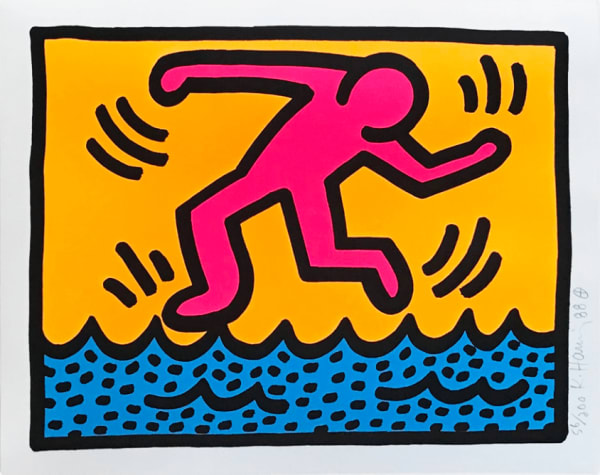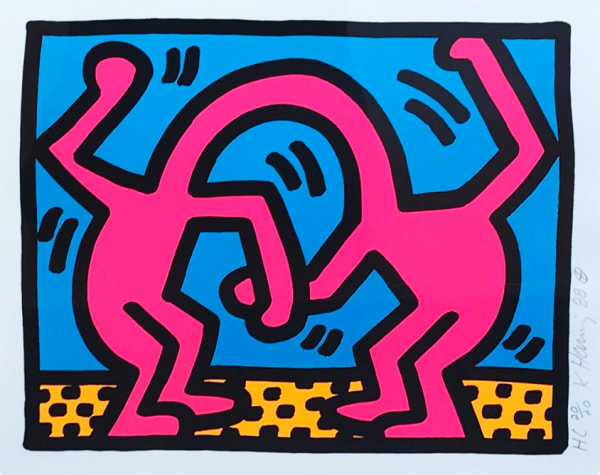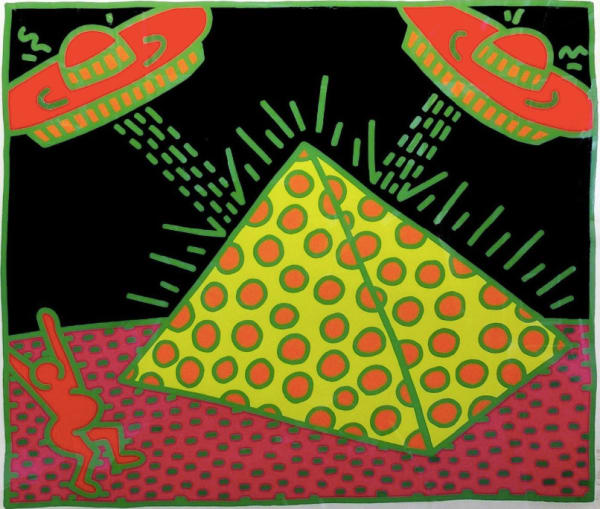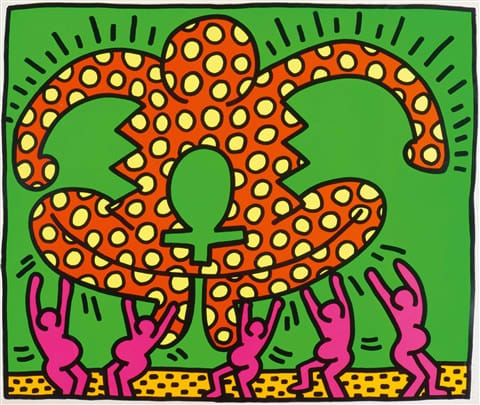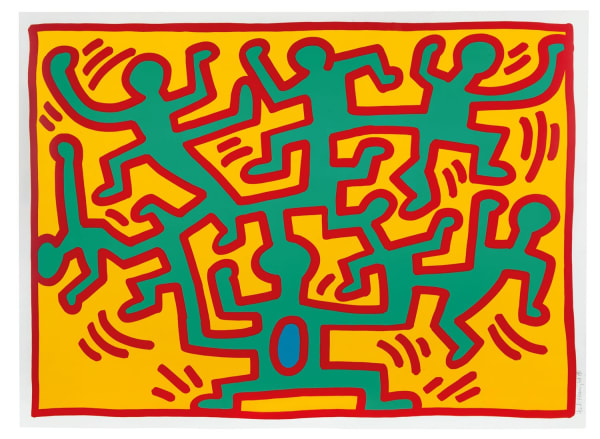A serious Keith Haring collection is best understood as a set of exposures to a durable visual language rather than a grab-bag of images. Over the last quarter-century, the print market has moved from consolidation to global depth, with complete sets and lifetime-signed works defining the high end while iconic single plates provide liquidity and on-ramps to larger positions. The core strategic fork remains unchanged: lifetime signed versus estate-stamped. Institutions and top private buyers consistently pay a premium for lifetime signed material because the artist’s hand confers both psychological and scholarly value, while estate-stamped issues remain fully legitimate but generally trade as a tier below on long-horizon appreciation. When the market leans in, capital flows first to lifetime signed complete sets, then to lifetime signed singles with canonical motifs, and only afterward does it lift estate-stamped impressions; that order of operations has repeated across multiple cycles and helps explain pricing spreads today.
From 2000 to Now
A short history of the last twenty-five years clarifies why the top of the Haring print market now behaves like a genuine “portfolio class.” In the early 2000s, prints were still rediscovering their buyer base outside New York and Western Europe, with the Littmann catalogue raisonné supplying the taxonomy collectors needed to navigate series, states and paper. The 2008–2009 financial crisis interrupted turnover but never broke thesis; Haring’s instantly legible iconography and broad cultural recognition kept demand resilient, and prices resumed their climb as macro conditions normalised. By the mid-2010s, complete sets and lifetime signed material had begun to decouple decisively from the rest of the field. Even in 2015, when Architectural Digest previewed a complete “Andy Mouse” set at Christie’s at a then-punchy estimate of $300,000–$400,000, close watchers could see what was coming: the series sits precisely where Haring’s downtown graphic democracy meets global consumer iconography, and that fusion was always going to command index-level attention as the collector base globalised.

Haring Goes Stratospheric
The 2020s supplied the hard proof. In October 2021, Christie’s New York placed a lifetime-signed “Growing portfolio” at $412,500 including premium, confirming the appetite for large-format, conceptually coherent sets and giving collectors a clean benchmark below “Andy Mouse.” That result mattered because “Growing” often serves as the first “set-as-thesis” anchor for buyers building toward apex holdings. Two seasons later the category’s ceiling shifted again, when a complete “Andy Mouse” suite in September 2023 reached roughly $1.21 million buyer-paid at Christie’s New York, a print-market milestone that instantly re-priced the top end and pulled strong single plates up behind it. In April 2025, Heritage Auctions validated that trickle-down with a single “Andy Mouse” plate achieving $325,000—a fresh auction record for an individual sheet in that house and further evidence that fractional exposure to the apex set now trades at a structurally higher level. Together, those three moments—“Growing” at $412,500 in 2021, the complete “Andy Mouse” at about $1.21 million in 2023, and the $325,000 single in 2025—outline a market that is deeper, better capitalised and more comfortable paying for lifetime signatures, scale and conceptual unity.

Below the apex, the engine of liquidity remains the Pop Shop suites and other immediately recognisable compositions. Auction houses have regularly moved complete Pop Shop sets in New York, London and Hong Kong, a geographic spread that helps reduce exit risk and supports consistent comparables. Sotheby’s recent London sales have shown confident estimates and healthy sell-through for “Pop Shop I,” while Phillips’ Hong Kong salerooms underline that Haring prints are not dependent on a single region to clear. This global cadence is precisely the behaviour sophisticated print investors value: frequent, geographically distributed turnover in canonical images across multiple houses.
The middle market has also matured. Price and volume data collated by specialist platforms indicate rising average selling prices for Haring prints through 2023–2025 despite uneven macro conditions in the wider art market, with total sales values holding at or near prior peaks as lot counts fluctuated. This is the signature of a market where quality and recognisability are doing the heavy lifting even when overall risk appetite cools. Financial-press coverage of the broader evening-sale environment in 2024 described a more selective, price-conscious top end, which makes Haring’s print resilience particularly notable in the same period; the combination of brand comprehension, institutional familiarity and well-documented comparables has continued to attract capital to the print segment when other categories softened.
|
Year |
Market context and milestone |
Indicative price impact |
|
2000–2007 |
Consolidation phase; global buyer base widens beyond US/EU; Littmann catalogue standardises taxonomy. |
Gradual uplift in signed sets and iconic singles. |
|
2008–2009 |
Macro shock slows turnover; thesis intact due to brand legibility. |
Temporary pause; quality discounts narrow quickly post-crisis. |
|
2015 |
Complete “Andy Mouse” previewed with $300k–$400k estimate at Christie’s, signalling institutional confidence in set premium. |
Forward indicator that apex set would re-rate. |
|
2021 |
“Growing” complete set achieves $412,500 at Christie’s New York. |
Re-prices large, lifetime-signed sets as portfolio anchors. |
|
2023 |
“Andy Mouse” complete set brings about $1.21m buyer-paid at Christie’s New York. |
New print-category benchmark; pulls strong singles up. |
|
2025 |
Single “Andy Mouse” plate realises $325,000 at Heritage. |
Confirms fractional exposure to apex set trades at higher base. |
What to buy now (actionable, collection-building choices)
$20,000–$50,000
If you are allocating $20,000–$50,000 today, the goal is to enter with purpose rather than scatter. Focus on lifetime signed single sheets from the Pop Shop universe and other compositions such as the Icons portfolio whose imagery reads in a split second—the barking dog, the radiant baby, the dancing figure and allied core symbols—where colour density is crisp, margins are full and provenance is linear. The reason is exit liquidity: canonical lifetime-signed imagery is easier to sell, produces cleaner comparables and leaves you one acquisition away from building toward a set. Other noteworthy examples
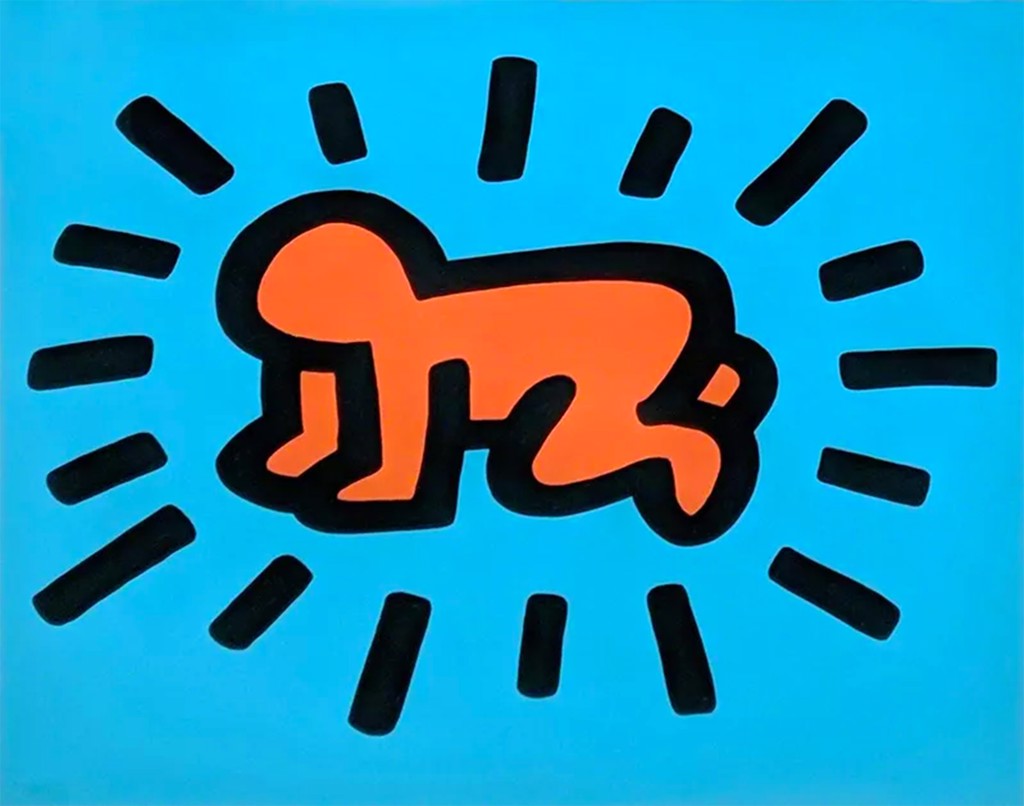
$50,000–$100,000
If you are allocating $50,000–$100,000, you are in position-building territory. The most rational move is to add the stronger lifetime-signed plates in the exact series you already own and work deliberately toward complete sets. A full suite is not simply four singles; it is a concept, and the market pays a conceptual premium because museums and seasoned collectors think and display in series. In practice that means prioritising clean, lifetime-signed Pop Shop sets or moving on well-preserved “Fertility” or “Growing” plates when they appear, with the explicit aim of completing the set within your holding period.

$100,000 +
At $100,000 and above, the target should be apex exposures with robust, recent comparables: a complete “Andy Mouse” suite when the opportunity exists; failing that, best-in-class single plates with signatures, paper and provenance that would withstand institutional scrutiny; and complete, lifetime-signed “Growing” or “Fertility Suite” portfolios where condition and paper brightness are beyond reproach. Works including “Medusa”, “Retrospect” and “People Ladder” continue to attract the upper level of collectors. The 2021 “Growing” and 2023–2025 “Andy Mouse” benchmarks provide the data spine for pricing and justify paying correctly for truly fresh, truly clean examples.

For collectors who already own Haring and want to upgrade intelligently, the most value-accretive step is to transform partial ownership into a complete set. Converting two or three plates into a full Pop Shop suite locks in the conceptual premium the market repeatedly rewards. The same logic holds for “Growing” and “Fertility.” Patience in sourcing the missing plates typically yields asymmetric payoff versus buying an unrelated single in a different series, and recent auction seasons have confirmed that complete, lifetime-signed sets with clean provenance energise bidding and clear at healthy multiples relative to their component parts.
Why Haring Keeps Working
Haring’s popularity is not a fashion spike but a cultural constant. His images function as a lingua franca of late-twentieth-century optimism—joy, movement, rhythm, civic-mindedness—and they translate across borders without explanation. That is why the category stayed liquid during the selectivity of 2024 and why prices at the top end reset higher in 2023–2025. When an artist’s most recognisable works can be understood instantly by new buyers in New York, London and Hong Kong, the market can widen without an education bottleneck, and prints become the natural mechanism for capital entry. The repeated appearance of strong results for apex sets and high-impact singles, alongside stable turnover in core Pop Shop imagery, is the pattern you would expect from a mature, geographically diversified market.
Predictions for 2026
The most likely scenario is continued selectivity at the very top of the broader contemporary market but sustained bid depth for Haring’s canonical, lifetime-signed print material. The $1.21 million “Andy Mouse” suite in 2023 and the $325,000 single-plate record in 2025 have established a higher reference range; absent a severe macro shock, the floor for best-in-class “Andy Mouse” singles should remain firm and the probability of another million-dollar-plus result for a pristine complete set is non-trivial given the thin supply of truly fresh examples. The second-tier of apex sets should continue to benefit from collectors seeking scale and narrative coherence below the “Andy Mouse” price, especially where provenance is strong and paper brightness is demonstrably original. The signed versus estate-stamped spread is likely to widen modestly, not because estate issues lose legitimacy but because institutions, advisors and private banks continue to guide clients toward lifetime signatures in a more data-driven environment. The middle market should remain healthy for Pop Shop suites, with Hong Kong and London contributing consistent turnover that keeps exit risk low; rising interest from younger collectors in Asia and the Middle East provides a structural demand tailwind for instantly legible imagery. A final and important nuance is framing and conservation: buyers are becoming more condition-literate, and works with conservator documentation, UV-safe glazing and original, unfaded paper are likely to command outsized premiums versus superficially similar examples.
In short, 2026 should reward discipline: lifetime signatures over estate when budget allows, complete sets over a basket of unrelated singles, and apex imagery over esoteric compositions. The data from 2021 through 2025 point to that outcome and offer a clear roadmap for allocating capital accordingly.
For more information on currently available Keith Haring signed prints for sale, contact our teams via info@guyhepner.com. Alternatively, if you wish to sell your Keith Haring prints, we can help. Speak to our New York and London teams today for a complimentary appraisal.






